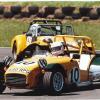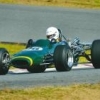Odd Repco F5000 engine
#1

Posted 13 December 2017 - 00:50
https://racecarsdire...er-f5000---1971
Was there ever such an engine?
Also the ad states it is running on Dellorto carbs. From memory and photos since I thought all the Repco F5000 engines were fuel injected?
Any views?
Advertisement
#2

Posted 13 December 2017 - 01:41
"full aluminium Repco F5000 engine"
Or a V8 with Repco heads ?
#3

Posted 13 December 2017 - 01:56
I see in this Swiss ad for a F5000 that it has a "full aluminium Repco F5000 engine"
https://racecarsdire...er-f5000---1971
Was there ever such an engine?
Also the ad states it is running on Dellorto carbs. From memory and photos since I thought all the Repco F5000 engines were fuel injected?
Any views?
Yeah, i remember the all alloy BL motor that they tried to make competitive.Somewhere along the line it got a Repco moniker stuck on it possibly because of Phil Irvings input and early Repco design help.
The official Repco F-5000 used the cast iron Holden block.
After saying all that i never really got into F-5000,for some reason, after 6+ years of F-1 cars in the Tasman Series so there will be people on this Forum that actually raced these so will know more than me.
Edit...quick Google showed this...looks like it this car..."Just found a reference in my notes to the hill climb car: Bryan Eccles' ex-MacDowel/Voigt/David Fyfe/Alex Brown 1971 Palliser WDH1 with 4.2 Repco (Autosport 8 Apr 1976 p59 and 1 Apr 1976 p61). Eccles crashed it very badly and injured his legs."
and....
https://www.facebook...851306298315949
Edited by Ian G, 13 December 2017 - 02:33.
#4

Posted 13 December 2017 - 02:33
It was stretched to 4931cc from the 4.4-litre Leyland P76 (or Leyland truck) V8. I don't recall those cast rocker covers. And naturally enough it was fuel injected at that time.
John conspired with Irving to develop this engine for the Elfin ML6 for the 1974 Gold Star, but it was fraught with problems and shelved and the Repco Holden engine fitted to this car (then called the MR6) won the Gold Star for him in 1975.
Tiring of Cooper's lack of ability to build a truly modern chassis, John reasoned that an F1 car using the Dunlops used at the Japan GP of 1976 would be a good bet using the Leyland-based engine. He bought the ex-Revson McLaren M23 (from Dave Charlton?) and went to a lot of trouble to ensure the modifications to fit the Leyland engine could be readily reversed.
He won the 1977 Gold Star with it. Later he and Irving developed the IMC heads to suit this engine, but they barely had a chance to prove themselves before he gave up racing.
As a final fling he was going to run the car in the 1980 AGP, with it prepared to the hilt to meet the challenge. But a car crash on the way to the event put an end to that and the car was dismantled and sold to Tom Wheatcroft IIRC.
.
Edited by Ray Bell, 13 December 2017 - 08:00.
#5

Posted 13 December 2017 - 04:12
Current ad doesn't really say how big, apart from "full".
#6

Posted 13 December 2017 - 05:56
The Holden 5000 engine was a production block, though reputedly a bit special in a few areas and a better material. I suspect the hi nickel Chevrolet used on the 5000, Z28 etc blocks. Heads reputedly a bit better around valve seats as well to stop the cracking with bigger [not much] valves.
The only alloy Repco engines were the F1 type Buick/ Olds based engine. And worth a good deal for the right buyer for historic racing.
McCormacks Leylands were Leylands not Repcos. Light, unreliable , underpowered and viabrated bad! At best an average engine even with the special heads made later. This from people who worked there in period.
#7

Posted 13 December 2017 - 05:57
I have seen a report that it originally had a Repco 740 engine stretched to 4.2L.
Current ad doesn't really say how big, apart from "full".
Roger Harrisons Tiga hillclimber was just under 5 litres. How? I have no idea but that is A what it was entered as B. What people around him confirmed.
And still usually got beat by Rohrlach and the VW!
#8

Posted 13 December 2017 - 06:18
Originally posted by TerryS
I have seen a report that it originally had a Repco 740 engine stretched to 4.2L.....
What originally had a Repco 740, Terry?
Of course the Repco engines were made in that size. 2.5, 3.0, 4.2 and finally 5.0 litres, but the latter only with the bespoke block.
#9

Posted 13 December 2017 - 06:25
Originally posted by Lee Nicolle
.....McCormacks Leylands were Leylands not Repcos. Light, unreliable, underpowered and vibrated badly! At best an average engine even with the special heads made later. This from people who worked there in period.
Witness this picture, from above, Lee:

See that it says 'Repco' there.
And they were light, 349lbs against about 500 for a Chevy. As I mentioned, that's why it was chosen.
And McCormack won a number of races with it, as well as the Gold Star. It never did any serious time with the IMC heads.
#10

Posted 13 December 2017 - 06:37
#11

Posted 13 December 2017 - 06:53
What originally had a Repco 740, Terry?
This particular car Ray, which started life as a stretched F2
#12

Posted 13 December 2017 - 07:29
Palliser built two cars. The MacDowell car started off with a 3.0 litre version of the 740 Repco unit in 1971. For 1972 the car was run with a 4.2 litre version by Peter Voigt whilst MacDowell ran a 5.0 Repco 740 in the new Brabham BT36X.
#13

Posted 13 December 2017 - 07:47
Witness this picture, from above, Lee:
See that it says 'Repco' there.
And they were light, 349lbs against about 500 for a Chevy. As I mentioned, that's why it was chosen.
And McCormack won a number of races with it, as well as the Gold Star. It never did any serious time with the IMC heads.
Ray, that is a sticker. What you found on the rocker cover of a Holden engine. Repco had a small bit to do with the Leyland project. But it was Macs project at his cost. A couple of others tagged on Macs Leylands as well. John Moyle used one with little success in a speedway Modified/ sprintcar before going back to a Ford. That was in direct consultation with Mac. And a couple of others tried them in Sports Sedans and Sports cars too. Without much success. And a fair amount of cost.
Remember the amount of hassle Repco had with the 3 litre Buick/Olds based engine. And the P38 was a derivation of that. And look at a V6 iron Buick/ Holden. Same engine family and never known for great strength either. All of those engines are adequate stock ofcourse but sketchy when modified. The Traco Olds early on were better than some.
The Repco Holden did come in a few forms too, I know of one that used a single carburettor as that was all that was allowed in Speedway sedans at the time. The engine was bought new from Repco. The next car though used a Chev!
As for winning a championship? Yeah as the opposition by then was so weak with either average drivers or budgets by that time.
The Holden was marginally lighter than a Chev but the Chev was by far the strongest and most powerfull engine.
And as for weight on Chevs, depends on the engine and what heads were being used. Blocks vary 20-30 lbs plus any lightening programme and an alloy heads 40-50 lbs, plus some more power. And some engines used mag intakes for a few less lbs as well. So weight numbers are very dodgey.
Like some who were there the Leyland was expensive and hi maintenance. plus the viabrations were meaning a lot of re rivetting as well.
I am surprised actually that more did not use the Ford Windsor as they were very small and would be as strong as a Holden and smaller. A Boss style engine while heavier [those Clevo heads] would probably make more power than the iron head Chevs though be a bit peakier.
As a total aside I would be very surprised if that engine did not have oiling issues as well. A V belt driving a dry sump system is a no no. Tooth belt there is imperative. This again from an ex McCormack staffer. And every book I have ever read and name engine builders as well.
Those 3 stage pumps use around 30hp, about double the factory pump. But with about 100% better reliability in a race application. For performance street use a wet sump is fine, on a Chev all you need is the factory 55lb psi pump.
The water pump is also 10-15hp though V belts seem more reliable in that application for some reason. Though replace belts regularly as they lose grip after a while. I used to replace both belts every 3-4 meetings and never had a problem. Though one tooth belt was half torn through, probably a stone had gone through it.
Edited by Lee Nicolle, 13 December 2017 - 08:10.
#14

Posted 13 December 2017 - 07:47
#15

Posted 13 December 2017 - 08:25
I would suspect this is based on the bigger Rover V8. It was from the Rover that the Leyland engine was taken, getting an extra inch of deck height to enable the capacity to be enlarged with some stroking.
Does anyone know what changes were made later in the Rover engine's life?
#16

Posted 13 December 2017 - 09:58
Edit...quick Google showed this...looks like it this car..."Just found a reference in my notes to the hill climb car: Bryan Eccles' ex-MacDowel/Voigt/David Fyfe/Alex Brown 1971 Palliser WDH1 with 4.2 Repco (Autosport 8 Apr 1976 p59 and 1 Apr 1976 p61). Eccles crashed it very badly and injured his legs."
That's from Yours Truly, on 10 Tenths in 2004.
The Palliser WDH1 was built for MacDowel for the 1971 hillclimb season, using a Palliser WDB3 Formula Atlantic chassis mated to a 3-litre Formula 1 Repco 740 V8 engine. In August it was expanded to 4200cc, which Autosport said "was achieved by fitting the 5 litre crank and rods". It still had the Repco in it when Eccles crashed it.
(Not to be confused with the WDH2 (of WDH/2), which was built for Jack Maurice and used the 4.2-litre General Motors V8 engine and gearbox from the Marsh Special.)
The ex-MacDowel car was in Germany last time I checked, and was fitted with a 4200cc "Rover-Repco" according to its HVIF. I suspect that is a Rover/Buick engine rather than the original Repco 740, but I'll leave that question to the experts.
#17

Posted 13 December 2017 - 10:05
That's the question. It's not a Repco cylinder head as used in F1 etc.
#18

Posted 13 December 2017 - 10:06
Isn't this the ex-Adrian Stoop car ? He ran it in the HSCC Single Seater series and the FORCE series in the 1990s and 2000s and I remember seeing it at Thruxton in about 1994 . That day David Methley drove it and the car was described as a Palliser Rover with an engine capacity of 3.9 litres . What the history of the car before this was I don't know but looking at the picture in the ad it certainly looks like the ex-Stoop car .
I believe that was the other one, the ex-Jack Maurice car. Didn't Brian Cocks and Mike Pendlebury drive it in HSCC events before Stoop?
#19

Posted 13 December 2017 - 10:13
Advertisement
#20

Posted 13 December 2017 - 11:29
I bow to your superior knowledge Allen ! The car was around the HSCC events for a long time , and it was driven by Cocks and Pendlebury as well I seem to remember . Did it not race in European F5000 at all in period ?
And Mike Littlewood and Nick Overall quite possibly. I have results for it in my database for the early 1990s, but I may have missed some late 1980s HSCC races.
No, neither of the WDH1s appeared in F5000 in period. There was a Palliser F5000 car, the former Franklen project, but that had been renamed again to Mildren by the time it first raced.
#21

Posted 13 December 2017 - 11:46
That's from Yours Truly, on 10 Tenths in 2004.
The Palliser WDH1 was built for MacDowel for the 1971 hillclimb season, using a Palliser WDB3 Formula Atlantic chassis mated to a 3-litre Formula 1 Repco 740 V8 engine. In August it was expanded to 4200cc, which Autosport said "was achieved by fitting the 5 litre crank and rods". It still had the Repco in it when Eccles crashed it.
(Not to be confused with the WDH2 (of WDH/2), which was built for Jack Maurice and used the 4.2-litre General Motors V8 engine and gearbox from the Marsh Special.)
The ex-MacDowel car was in Germany last time I checked, and was fitted with a 4200cc "Rover-Repco" according to its HVIF. I suspect that is a Rover/Buick engine rather than the original Repco 740, but I'll leave that question to the experts.
I always thought the 4.2 litre Repco engine was from the Brabham Indy Car/USAC car......
#22

Posted 13 December 2017 - 11:52
But what is Repco on it?
That's the question. It's not a Repco cylinder head as used in F1 etc.
Isn't that the original Repco logo, pre-Brabham association.
#23

Posted 13 December 2017 - 12:56
I wouldn't say, however, that it didn't remain during and/or after the Brabham engines F1 era.
I would say that the rocker cover shown is not a camshaft cover, however.
#24

Posted 13 December 2017 - 13:29
I would say that the rocker cover shown is not a camshaft cover, however.
Looks ohv not ohc, no cam drive visible
#25

Posted 13 December 2017 - 13:47
So what engine is it? Why has someone gone to the trouble of making those rocker covers?
#26

Posted 13 December 2017 - 15:37
I always thought the 4.2 litre Repco engine was from the Brabham Indy Car/USAC car......
I suspect that is a coincidence. This sounds like a 3-litre bore + a 5-litre stroke = 4.2-litre
#27

Posted 13 December 2017 - 21:27
But Repco had been making single-cam 4.2 engines for sports cars from 1966.
.
Edited by Ray Bell, 13 December 2017 - 21:28.
#28

Posted 13 December 2017 - 23:20
Looking forward to see exactly what Repco pushrod motor it is,looks like a variation of the Leyland engine but as mentioned the Rocker covers are interesting,Irving did cast new heads for the F-5000 BL project but i thought they had Leyland on the Rocker Covers.
Evan Green wrote several articles on the Motor but only one general Info. type is showing via Google.
#29

Posted 14 December 2017 - 00:21
Three distinct engines there. First one in the car is on carbs. I guess the oldest 60s Repco engine discussed above. As is he one on the Repco stencilled box also with the waterpump on the engine plate and the black and white shot shows what I presume to be Macs 5000 engine.
#30

Posted 14 December 2017 - 02:01
And the one on the box doesn't look like any Repco engine I've ever seen.
#31

Posted 14 December 2017 - 05:10
Yeah,first Pic. and last are from the original 'For Sale' link.I'm assuming the last Pic. on the crate is the first Engine/Pic. out of the car.
#32

Posted 14 December 2017 - 07:09
Check this one from the Adelman's BT6:

#33

Posted 14 December 2017 - 08:48
No, Lee, just two engines there...
And the one on the box doesn't look like any Repco engine I've ever seen.
The very early ones were modified Buick/ Olds engines. And looked like it.
Where is Kaydee, he could answer most of the questions
#34

Posted 14 December 2017 - 13:12
No pushrods like this one.
#35

Posted 14 December 2017 - 14:28
the rules for f-5000 allowed 3L race motors or 5 L stock blocks
repco built a new block for the buick/olds 66 f-1 motor in 67
that block was also used at indy and as a twin cam in 68 f-1 and other classes in 2.5 3.0 4.2 indy and 5.0 for sportscars
so did they later use the f-1 block tooling to make a f-5000 legal pushrod motor ?
or is it Leyland of Australia produced a 4,414 cc (269.4 cu in) version of the aluminium V8 for their Australia-only 1973 Leyland P76.
the later landrover 4.5 and 5.0 redone buick based blocks were after this repco motors date
#36

Posted 14 December 2017 - 14:40
the rules for f-5000 allowed 3L race motors or 5 L stock blocks
Only in North America. From memory the European series didn't allow racing engines and in Australasia the previous capacity limit of 2.5 litres was retained. Derek Bell (1970) and Chris Amon/David Oxton (1971) would had achieved better Tasman results if they'd had DFV rather than DFW power.
#37

Posted 14 December 2017 - 14:59
Originally posted by ray b
.....so did they later use the f-1 block tooling to make a f-5000 legal pushrod motor?
or is it Leyland of Australia produced a 4,414 cc (269.4 cu in) version of the aluminium V8 for their Australia-only 1973 Leyland P76.
the later landrover 4.5 and 5.0 redone buick based blocks were after this repco motors date.
All correct, as covered earlier in the thread...
No, there was no way you could possibly make a F5000-legal engine out of the CAC-cast Repco block. Not ever used in production cars, no provision for a camshaft in the block either.
When it comes to overhead cams in F5000, apart from the American regs, there was some provision at some time in the late seventies for engines like the Cologne Capri V6 to be used.
#38

Posted 14 December 2017 - 16:30
All correct, as covered earlier in the thread...No, there was no way you could possibly make a F5000-legal engine out of the CAC-cast Repco block. Not ever used in production cars, no provision for a camshaft in the block either.When it comes to overhead cams in F5000, apart from the American regs, there was some provision at some time in the late seventies for engines like the Cologne Capri V6 to be used.
I think the capacity limit in the early days of F5000 for "racing engines" was 2.5 litres eg. Gus Hutchinson's Brabham BT26 in the States.
There were a few Weslake headed Cologne V6s in the latter days of F5000 called the Shellsport Series in the UK
#39

Posted 14 December 2017 - 19:04
I note the car won a NSW Hillclimb Championship.Was it a ex F5000 car or purpose build by Bowin for Barrie?
Finally,does it still exist?
Thanks in advance.
Advertisement
#40

Posted 14 December 2017 - 19:34
I think the capacity limit in the early days of F5000 for "racing engines" was 2.5 litres eg. Gus Hutchinson's Brabham BT26 in the States.
I think you may be confusing the grandfathered Tasman ANF1 limit of 2.5-litres used in Australia. The limit in the US was the grandfathered Formula A limit of 3000cc. Hutchison had a normal 3-litre DFV.
There were a few Weslake headed Cologne V6s in the latter days of F5000 called the Shellsport Series in the UK
The Cosworth GAA engine was allowed in European F5000 from 1974 onwards.
#41

Posted 14 December 2017 - 19:47
This has probably been answered but just looking at the cylinder head ex. port spacing it is obvious what ever that block is the heads are the G.M./Rover alloy heads which makes it obvious it is a push-rod engine based on that .
#42

Posted 14 December 2017 - 20:25
Apologies about the possible thread drift but was the Leyland based engine in Barrie Garner's Bowin Hay associated in any way with John Mc's project?
I note the car won a NSW Hillclimb Championship.Was it a ex F5000 car or purpose build by Bowin for Barrie?
Finally,does it still exist?
Thanks in advance.
It was purpose built for Barrie and I think it still exists.
Dale.
#43

Posted 14 December 2017 - 20:57
I think you may be confusing the grandfathered Tasman ANF1 limit of 2.5-litres used in Australia. The limit in the US was the grandfathered Formula A limit of 3000cc. Hutchison had a normal 3-litre DFV.
The Cosworth GAA engine was allowed in European F5000 from 1974 onwards.
That will teach me to trust my memory!!
Edited by bill p, 14 December 2017 - 20:57.
#44

Posted 14 December 2017 - 22:56
I'd imagine that Barrie did his own mods on the engine, too.
#45

Posted 15 December 2017 - 06:36
If you look on many motorsport websites the original GM engines, then the Rover versions have been used quite a lot. From the time of release in the early 60s. Because they are a simple V8 and are light. And The Poms used them because they were common. Serviceable as a mild performance engine. But they are far from a good racing engine.
That is why serious commonsense racers and raceteams have used Chevs, Fords, Mopars and the odd Holden or 3. They may be heavier,, but you can make very good power without them constantly failing. And even in the 60s serious performance parts were available.
Unlike the 4.4 Leyland that is the reason 173 Holden pistons are sold in sets of 8! True performance parts are all custom made.
#46

Posted 15 December 2017 - 12:08
The Barrie Garner car was a P6 altered to suit the Leyland engine...I'd imagine that Barrie did his own mods on the engine, too.
The Barry Garner car started life as an ANF2 P6 built initially for Bruce Alison. It was was extensively modified by Ron Hay for Barry,
, fitted with the Leyland V8 and renamed the Bowin Hay. After a successful career in Barry’s hands it was later sold to a young guy from Wollongong (Mike ?,) who’s sustained serious injuries in a crash at Canberra hill climb.
#47

Posted 15 December 2017 - 13:18
Yes, I'd forgotten the car had come from Allison. And I was struggling with Ron Hay's name too.
#48

Posted 16 December 2017 - 01:13
According to the Repco site the logo that's on the Rocker Cover and crate is out of the 1960's,strange unless the Rocker Cover is a replica that's been cast by somebody.
http://www.repco.com...out Us~&2=~&3=~
#49

Posted 16 December 2017 - 06:07
Those rocker covers are not from Repco and they're not replicas of anything from Repco.
#50

Posted 16 December 2017 - 10:47
Not that it matters as eventually someone will contact the seller but the Logo is Repco's from the 1960's as listed in my link,understandable that it be on the crate but there must be story as regards the Rocker Cover.
I've also been told,and its confirmed in the previous ,link that the Repco-Brabham Engine Co. and the Repco Engine Development Co. were separate divisions,The Repco Holden F-5000 engine came from RED and also Leyland Aust. paid RED for early development work on the P-76 engine.
The BMC Forums in Aust. will have a field day with that Motor.
Edited by Ian G, 16 December 2017 - 10:56.






















